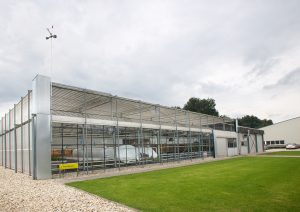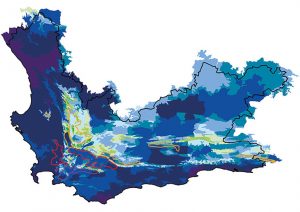
Future-proofing fruit production
Hortgro-funded projects that aim to develop a climate-change response strategy for the pome- and stone-fruit industry, and to investigate erratic weather conditions during early spring. By Jorisna Bonthuys.
The impact of climate change on agriculture can no longer be ignored and will continue over the next few decades. For instance, temperatures in fruit-production regions are rising, and daily maximum temperatures are already reaching record levels in certain places.
The most pressing questions for growers are: What does the climate look like in the foreseeable future? What climate aspects are changing the fastest and pose the most significant risks to pome- and stone-fruit farming? And what can growers do about it?
Providing answers to these questions is central to adapting to climate change in the sector, says Prof. Stephanie Midgley, Climate Change and Risk Scientist in the Western Cape Department of Agriculture. She leads an ongoing research project focused on conditions during the early growing season in production areas in the Western Cape and the Langkloof.
In recent years, many growers have had to deal with weather conditions never before encountered during spring. There have been seasons with unusual heat stress in late winter and spring, followed by cold and unpredictable weather. Heatwaves adversely affected fruit set in 2019, with late-season plums being hit by intense heat during blooming.
“If extended periods of high temperatures occur with higher frequency, this could result in an economically unsustainable situation,” warns Midgley. “We are trying to figure out the historical nature of unpredictable weather, what such instances could look like in the future, and the areas that will likely suffer the greatest impact.”
This research follows on earlier efforts that culminated in a growers’ guide to understanding climate change in key production regions. Read more about this project and the research that underpins it on page 22.
Filling knowledge gaps
Events of the past few years have highlighted gaps in recent quantitative climate modelling and mapping. There is a clear need to better understand historical and projected future temperature patterns and extremes in the early season, says Prof. Wiehann Steyn, general manager at Hortgro Science.
For this reason, Midgley, together with colleagues Prof. Roland Schulze from the University of KwaZulu-Natal and Nick Davis from Isikhungusethu Environmental Services, is analysing and mapping the possible differences between historical — 1950–1990 — and projected future — 2030s and 2050s — temperature patterns, and extremes in the early growing season. From this they can infer the risks and impacts related to dormancy release, flowering, fruit set, and yield, as well as risks to young crops from a photosynthesis and carbon-balance perspective.
As part of their work, the researchers will investigate cumulative chill and heat units; temperatures beyond the high and low thresholds that affect pollination, fertilisation, and fruit set; frost risks; day and night temperature variability; and leaf and fruit carbon balance, as affected by temperatures during early growth.
The goal is to determine the possible changes in chill and heat units during the transition from winter to spring, between the historical and future periods. They will also assess the interaction between dormancy and early-season reproductive processes, explains Midgley. This may assist in projecting possible impacts on fruit set, yield, and quality, and in identifying optimal production areas for the future.
The team will map their results for a set of four generic fruit types and selected key production regions. The types will include very-early-, early-, mid- and later-flowering cultivars of apples, pears, peaches or nectarines, and plums.
Understanding variability and change
In South Africa, pome fruit generally start flowering from September to mid-October. Extended cold weather during this sensitive reproductive period can harm fruit set and yield, especially in frost-prone areas.
An extended period of very warm winter days and nights, on the other hand, can prevent the accumulation of sufficient chill units, resulting in trees that do not fully exit their dormant state before spring. Such trees suffer delayed and protracted flowering, which in turn contributes to mixed fruit maturities, among other problems. Low-chill cultivars, on the other hand, may experience earlier flowering, whereas flowering in some stone-fruit cultivars may shift considerably between warmer and colder seasons.
Once trees become physiologically active, hot nights can potentially damage processes occurring during pollination and lead to low fruit set.
Both photosynthesis and respiration rates increase with a rise in temperature, but respiration rates do so more rapidly. Thus, at high temperatures, the carbon losses from respiration overtake the carbon gains due to photosynthesis. “This means that more reserves are utilised for growth,” says Midgley. “High spring temperatures and its effect on trees’ carbon balance can reduce cell division and lead to smaller fruit sizes.”
A strategy to deal with change
Midgley is also developing a climate-change response strategy for the stone and pome-fruit industry, in collaboration with Arthur Chapman, a hydrologist and climate-change scientist, and sustainability consultancy Blue North. The strategy targets the next 30 years, considering climate change projections for both the immediate — 2030s — and the intermediate — 2050s — future.
Over the next few months, Midgley will co-develop the strategy with industry stakeholders to ensure relevance and clear prioritisation. Adjustments will be made where necessary, based on grower and value-chain workshops, and on engagement with industry stakeholders.
“It is vital that the industry develops a consolidated, strategic and forward-thinking response strategy that will ensure timely and science-based responses to climate-related change and risks,” says Steyn.
The strategy will summarise the most important climate-change risks and impacts per fruit type and production region, and the necessary research, technology transfer, and skills development. A prioritised and consolidated set of adaptation and mitigation options will also be identified per fruit type and production region.
“If the sector is to adapt to the changing climate to remain profitable and competitive, a better understanding of the trends and projections for key climatic factors and their impacts on production in our region is needed,” says Midgley. “This strategy can help growers and the value chain prepare for the future.”






